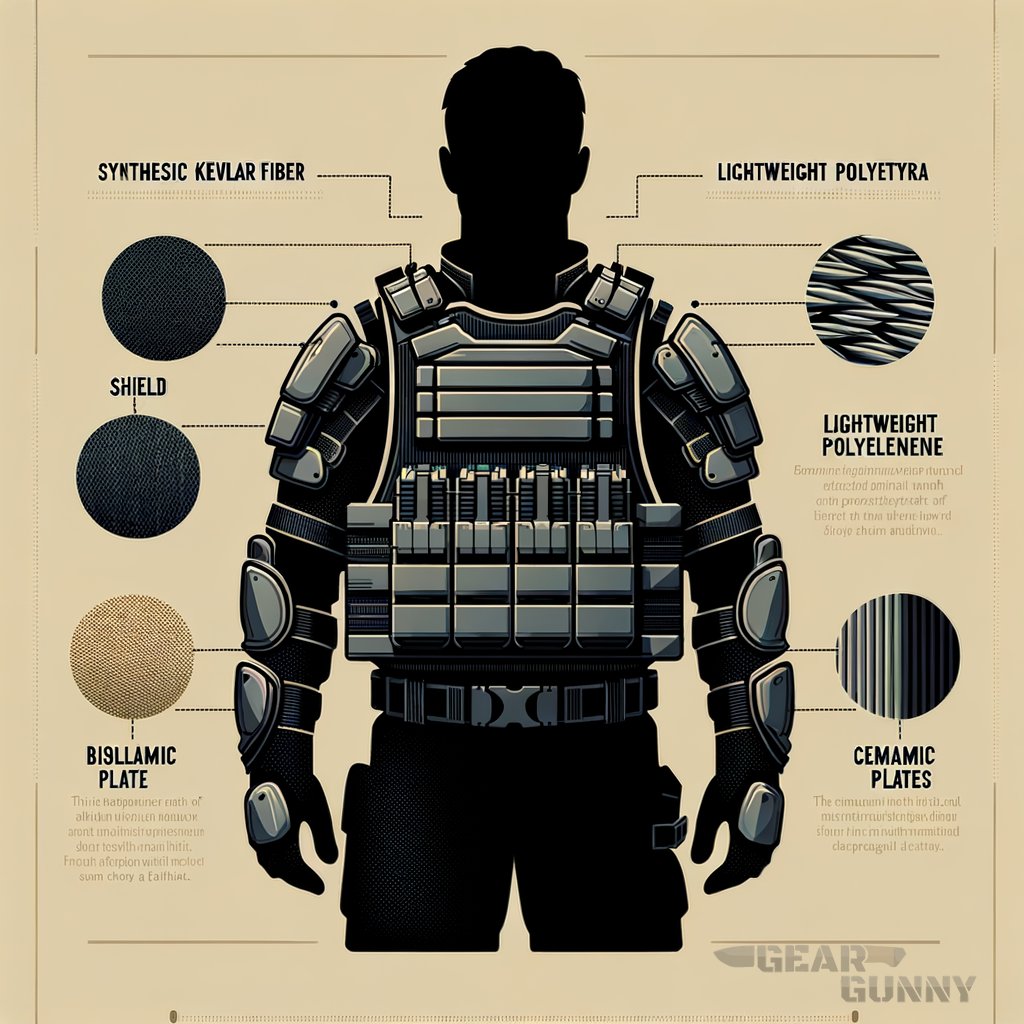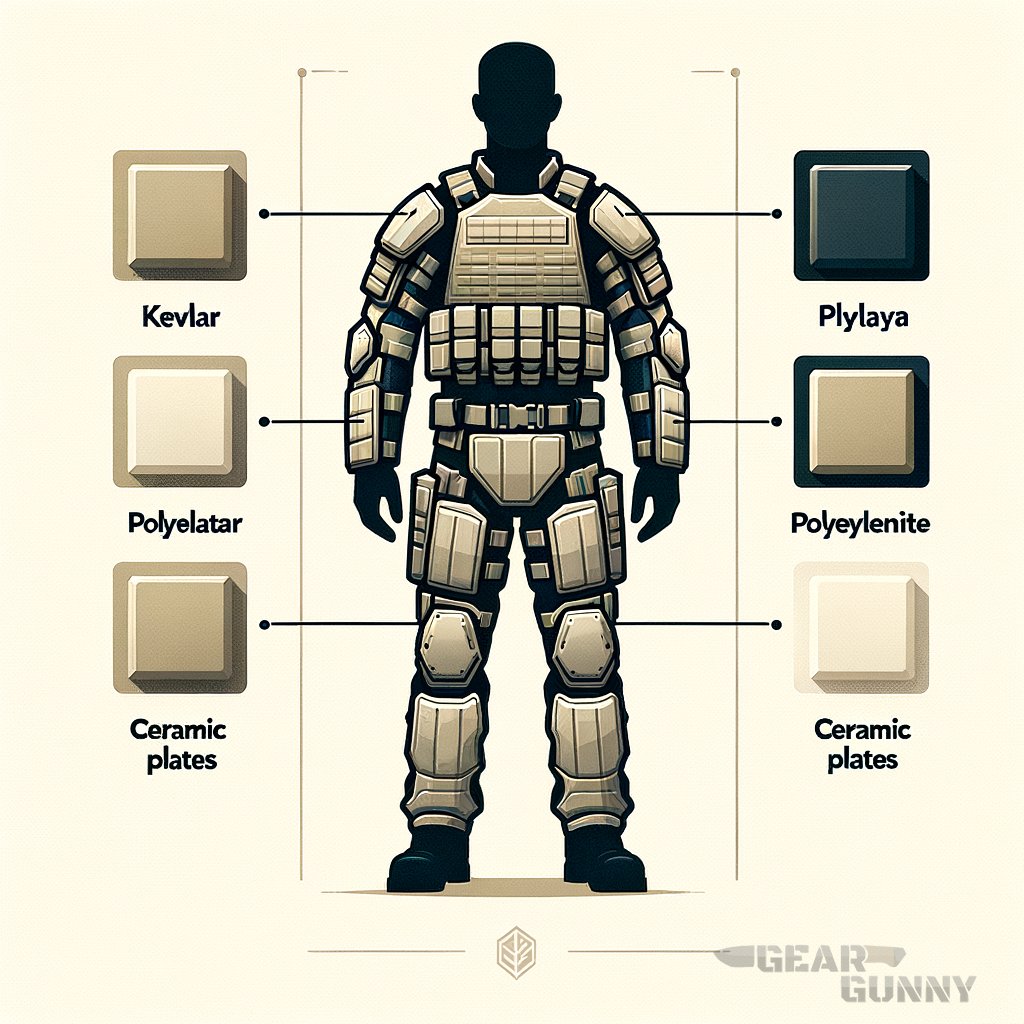Ever wondered how soldiers and law enforcement officers survive direct hits in combat? What makes their body armor so tough? If you’re curious, it’s all about the ballistic materials inside.
These materials play a crucial role in saving lives on the battlefield. In this post, we’ll dive into what makes these materials so effective, and how they manage to stop a bullet in its tracks. Check out the best options for plate carriers, which are the outer shells designed to house these life-saving materials.
What are ballistic materials in armor?
Ballistic materials, fundamentally, are the lifeblood of modern armor systems. They’re concocted to dissipate the energy of a fired projectile – a bullet, shrapnel, or explosive fragment – and prevent it from penetrating through to what’s most important: the wearer. Think of them as the shield bearing the brunt of an attack to protect the warrior.

- Kevlar: A well-known synthetic fiber, highly regarded for its exceptional strength and resistance to heat.
- Polyethylene: A lightweight option, usually used in conjunction with other materials to maximize protection while minimizing bulk.
- Ceramic plates: These act as the hard-hitting linebackers, shattering an incoming projectile and dispersing its energy across the plate’s surface.
These materials usually work together in layers, each contributing to the armor’s overall resilience. They’re meticulously engineered and tested repeatedly to ensure they meet stringent safety standards. But let’s not forget, while the materials are key, the overall design of the best plate carriers is just as crucial in ensuring that life-saving protection.
In my opinion, and remember, I’m no lab-coated scientist or engineer, these materials are nothing short of miraculous. They’re the unsung heroes that don’t just stop bullets; they save families from heartache. It’s hard to grasp what it feels like to trust your life to a piece of equipment unless you’ve been there, staring danger in the face.
I remember hearing about a buddy from my USMC days who swore his plate carrier saved his hide more times than he could count. Or how about that iconic scene in the movie where the protagonist gets shot, but thanks to his trusty armor, he lives to fight another day? It just shows the incredible affect these materials have on safety and survival.
Scrolling through some top-notch tactical gear, you’ll get a sense of the careful thought put into these lifesaving innovations.
5.11 Rush 24 Tactical Backpack

5.11 Rush 24 Tactical Backpack
Understanding ballistic materials in body armor
Ballistic materials are the cornerstone of effective body armor, shaping the protective gear’s ability to stop various projectiles. They’re selected for their unique properties that combat the high-speed impacts of bullets and fragments.
The role of Kevlar in body armor
Kevlar is synonymous with bullet-resistant gear. It’s a super-strong synthetic fiber that absorbs affect energy and reduces the risk of penetration. Its high tensile strength-to-weight ratio makes it an ideal candidate for personal protection.

“Ballistic materials are the cornerstone of effective body armor, shaping the protective gear’s ability to stop various projectiles. They are meticulously engineered and tested repeatedly to ensure they meet stringent safety standards.”
When a bullet hits a Kevlar vest, the fibers absorb and disperse the energy, causing the bullet to mushroom and slow, offering the wearer vital protection. Check out some of the best tactical gloves that use similar materials to safeguard hands.
How polyethylene fits into the armor puzzle
Polyethylene is known for its lightweight characteristics. The application of ultra-high-molecular-weight polyethylene (UHMWPE) in ballistic armor permits ease of movement along with protection. It works by spreading the force of the affect over a larger area, and its light weight ensures mobility isn’t compromised.
Ceramic plates: Stopping bullets in their tracks
Ceramic plates serve as the front line of defense in body armor. They’re hard, brittle, and shatter upon affect to disperse the energy of a bullet. This blunting effect is essential for preventing penetration.
While ceramics can be heavy, they are usually used in tandem with other materials for a balance of protection and practicality.
Types of body armor and their use cases
The spectrum of body armor levels
Body armor isn’t one-size-fits-all; it is categorized into different levels based on the protection it offers. From softer vests protecting against small-caliber rounds to hard plates that can stop rifle fire, the appropriate level depends on the anticipated threat.
Specialty applications of ballistic materials
Beyond standard body armor, ballistic materials find their place in a variety of protective equipment. Bomb disposal suits, armored vehicles, and even aircraft may employ these materials to safeguard lives from explosions and gunfire. Discover how the automatic locking system (ALS) in tactical gear also contributes to safety and protection.
Customization and the future of body armor
With advancements in material science, the future of body armor looks to lighter, more flexible, and even more protective solutions. Adding new technologies such as nano-materials and smart fabrics could revolutionize personal protection.
Maintenance and care for ballistic material-based gear
The longevity of ballistic materials in armor
Like any piece of equipment, body armor has a shelf life. Over time and with exposure to elements, materials can degrade. Proper maintenance and regular inspection are essential for ensuring protection remains uncompromised.
Best practices for storing and caring for armor
Storing armor properly when not in use extends its life span. Avoiding moisture, extreme temperatures, and folding or bending the plates ensures materials maintain their protective qualities. You can also find information on caring for gear such as tactical boots which, like armor, require proper maintenance.
Accessorizing your body armor
The importance of compatible gear
A plate carrier is only as effective as the accessories and complementary gear it’s paired with. Selecting the right pouches, hydration systems, and attachment points makes a significant difference in utility and comfort.
Upgrading your armor system
Incorporation of more protection elements, such as side plates or neck guards, enhances overall safety for various operational environments. Learn about other tactical equipment enhancements like the AMP™ comfort system that prioritize comfort along with protection.
When it comes to ballistic materials in armor, the data speaks volumes about their importance. Here’s a snapshot of what these materials can accomplish when it comes to keeping soldiers and law enforcement officers safe:
| Material | Use in Armor | Benefits |
|---|---|---|
| Kevlar | Vests, Helmets | High strength, heat resistant |
| Polyethylene | Plates, Shields | Lightweight, shock absorption |
| Ceramic | Hard Armor Plates | Bullet fragmentation, heavy affect resistance |
Kevlar remains dominant in personal armor by combining flexibility with impressive stopping power, polyethylene revolutionizes portability in the field of defense, and ceramics offer a tough barrier against high-velocity threats.
More ballistic materials tips
When it comes to using and understanding ballistic materials in armor, there are a few extra pointers that can enhance your knowledge and practical approach to these life-saving fabrics.
- Research and stay informed about the different types and grades of ballistic materials to match your specific needs.
- Consider the weight of the material; in some situations, mobility is just as important as protection.
- Familiarize yourself with the lifespan and warranty of your body armor to ensure it provides the expected level of protection throughout its use.
- Conduct regular maintenance checks and adhere to the manufacturer’s advice for care and storage to prolong the effectiveness of the ballistic material.
- For those in particularly hazardous duties, look into complementing your armor with more protective gear, such as helmets and side plates.
Understanding the dos and don’ts of using and maintaining ballistic materials can substantially affect their performance. Here’s what you need to know:
| Do | Don’t |
|---|---|
| Follow manufacturer guidelines for care and storage. | Neglect the importance of a proper fit for your body armor. |
| Store in a cool, dry place away from direct sunlight. | Expose armor to extreme temperatures or moisture for prolonged periods. |
| Inspect your armor regularly for signs of wear and damage. | Use armor that’s past its expiration date or has been compromised. |
| Understand the level of protection your gear offers. | Assume all armor provides the same level of protection. |

Advantages and disadvantages of using ballistic materials in armor
Ballistic materials have revolutionized personal defense, providing unprecedented levels of protection in various dangerous scenarios. Yet, like any technology, they come with their own sets of pros and cons.
Advantages
- Enhanced safety: Offer superior protection against bullets, stab wounds, and shrapnel.
- Innovation: Continued material science advancements lead to better, stronger armor.
- Comfort: Modern materials are lighter and more comfortable, allowing greater mobility.
- Durability: High-quality ballistic materials have long lifespans when properly maintained.
Disadvantages
- Cost: Advanced armor technology can come with a high price tag.
- Maintenance: Requires regular care and inspection to ensure continued efficacy.
- Heat: Some materials can retain heat, resulting in discomfort for the wearer.
- Weight: Even though advancements have been made, some materials can still be heavy, hindering agility.
While there are clear benefits to using ballistic materials in personal armor, potential downsides must be considered and mitigated through informed choices and proper usage.
If you are a visual learner, check out this video titled ‘Liquid Ballistic Armor? | Thehacksmith Collab’
Frequently asked questions (FAQ)
How do ballistic materials affect the comfort of armor?
Ballistic materials have greatly improved over the years, prioritizing not just safety, but also the comfort of the wearer. Modern materials like UHMWPE are incredibly lightweight, meaning the armor doesn’t weigh you down as much in the field and allows for better mobility and endurance during extended use.
Can ballistic armor be reused after an affect?
Generally, armor that has taken a ballistic hit should be replaced, not reused. The affect compromises the integrity of the materials. Especially in the case of ceramic plates, which may crack and lose effectiveness, it’s a one-time-use scenario.
Is there a significant difference between civilian and military-grade ballistic armor?
Yes, there is usually a notable difference between civilian and military-grade ballistic armor in terms of protection level, durability, and design. Military-grade armor is typically designed to meet specific combat standards, accommodating more extreme conditions and threats than what civilian armor is usually rated for.
Final thoughts
As we reach the tail end of our exploration of ballistic materials in armor, it’s clear that the subject is not only vast but also vital. The continuing evolution of armor technology promises even greater protection and agility for those who serve on the front lines, as well as civilians seeking personal safety. The careful selection and maintenance of these materials can be the deciding factor between harm and safety.
Always keep an eye out for the latest advancements and updates in the field of tactical gear, and ensure you’re adequately prepared for whatever threats you may face.
With all this information on ballistic materials in hand, do you feel more informed about the essential role they play in modern protective gear? Did I cover everything you wanted to know? Let me know in the comments section below I read and reply to every comment.
If you found this article helpful, share it with a friend, and check out my full blog for more tips and tricks on tactical military equipment and techniques. Thanks for reading, and stay safe out there, Devil Dogs!
- Ballistic materials like Kevlar, polyethylene, and ceramics are key to effective body armor.
- Care and maintenance of armor are crucial for **long-term protection**.
- Advancements in materials could lead to even lighter, more comfortable, and more protective armor.















